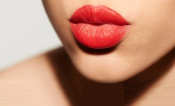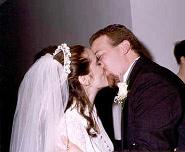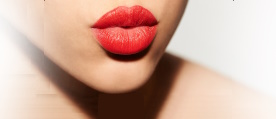What's in a kiss?
Kissing - one of mankind's better inventions
Support bacteria - they're the only culture some people have.
A warm, moist human mouth is a commune of over 400 different species of micro-organisms. Billions of the little rascals, who easily outnumber the human population of the world, live happily on teeth, the soft fleshy mouth surfaces, and especially the tongue. These bacteria thrive on all the sugar and carbohydrates we consume, and multiply until we next brush our teeth. Each time we kiss, we pass millions of them on to our partner.
So is that what's in a kiss? Or is there a bit more? You bet there is!
This page looks at the three types of kiss:
The Wedding Kiss is a combination of all three.
The 'Natural' Kiss
What's in a kiss?

"A kiss is a lovely trick designed by nature to stop speech when words become superfluous." (Ingrid Bergman)
Fortunately, around 80% of the bacteria we pass to our partner in a kiss are common to most people. Even more fortunately, the other 20% are unique to one person and are usually beneficial to their partner because they help the immune system create antibodies to the new bacteria.
Kissing can help our teeth by fighting plaque and cavities because kissing stimulates saliva that contains calcium and phosphorus. Don't stop visiting the dentist, but don't stop kissing either.

Kissing also cures hiccups (folk remedy), but there's no need to wait for that excuse to kiss someone.
There’s a myth that Inuit and Yupik kiss by rubbing noses. In reality, kunik (the so‑called “Eskimo kiss”) involves pressing the nose and upper lip against someone’s cheek or forehead and inhaling their scent – not exactly kissing, but an intimate gesture.
Of course, kissing can involve more than mouths – you can “kiss” with any part of the body, from playing footsie to holding hands. But mouth‑to‑mouth kissing is rather special.
Neuroscientists point out that such kissing employs the lips and tongue; highly sensitive areas with lots of afferent neurons sending signals to the brain to release endorphins. These chemicals make us go all gooey. Kissing burns up calories in exercising dozens of little face muscles, increasing blood circulation which helps smooth out wrinkles.
That means there's a physical and emotional benefit to the kisser and the kissed. Only a slight benefit of course, but a good excuse for a smooch.
It started with a kiss...
A: Neither. Kissing with lips is best.
Although we say we give a kiss, in fact a kiss is something we take. When we kiss, we inhale air rather than exhale. This sucking is a leftover from our infancy when we would have constant urge to intake sustenance. This need was satisfied by the mother, and so sucking became associated with satisfaction. This satisfaction became so strong in our little brains that even when there is no food, there is satisfaction; whether it's a child sucking its thumb or a smoker trying to quit.
Anthropologists tell us that way back in prehistoric times, mothers realised that babies choke to death on ordinary adult food. They also learned that babies thrive if fed on a meal pre-chewed by the mother. Holding a baby in one hand and a freshly slaughtered rabbit in the other, mouth-to-mouth feeding was found to be an efficient way to feed, with the minimum waste and maximum accuracy; just like chick birds are fed. Mouth-to-mouth feeding is still practiced in some cultures to this day.
From this feeding function, mouth-to-mouth contact became a sign of trust, dependence and affection between mother and child, and this comforting habit carried on into adulthood.
but by the moments that take our breath away.
Most people are right-handed and when fighting with daggers or swords, the weapon is in the right hand. Hand-shaking is customarily done with the right hand and it has been suggested that this began as a sign of trust, because that neither party would be holding a weapon. More than that, the feeling of trust is sincere enough for each party to give the other control of their stronger, fighting right-hand. That suggestion extends to kissing, where each party wishes to display such a deep trust that they are willing to give up control of their breathing. Such closeness leads us to...
The 'Sensual' Kiss

"A kiss is the shortest distance between two."
(Youngman)
In passion, kissing is done simply for the pleasure of kissing or as part of foreplay. Whether it's with eyes open or closed, a saliva-laden minuet, industrial vacuum cleaner, all-star tongue wrestling or tonsil hockey, the secret of a good snog is progressing slowly to discover what your partner responds to. Kissing is a very mutual activity. A selfish, one-sided kiss cannot possibly give the same satisfaction.
And here we move on.
There are already countless websites and blogs devoted to kissing fetishists, and with those we cannot hope to compete. So we'll now smooch on towards the wedding kiss - a combination of the natural kiss, the sensual kiss, and ...
The 'Symbolic' Kiss
Whilst we've said above that natural kissing evolved into sensual kissing, we take the view that symbolic kissing was invented by man; hence the title of this page: Kissing - one of man's better inventions.
The origin of the word 'kiss' is uncertain but might come from the Old English cyssan. It is similar to the Saxon kussian and kyssa in the Viking language. In all these languages, the word most likely evolved from an imitation of the sound of a kiss - an onomatopoeic word like 'splash', 'hiss', 'mumble' etc.
So finding the language and nation responsible for inventing the kiss is difficult. Research indicates that the Romans were pretty sophisticated kissers and took it to a fine art. Where they kissed depended on the relative importance of the kisser and kissed. Important visitors would greet their host by accepting and offering a kiss to the mouth. If the kisser was less important, they would kiss the hand, clothing or ring. The lowest ranking people would kiss the feet, or even the ground walked upon by a VIP.
The kissing of icons as a sign of veneration is common in many religions. In Mecca, the Black Stone has been worn hollow by centuries of kissing.
In Christianity, we see dozens of biblical references to kissing. The most infamous kiss was from Judas in betraying Jesus, and 2 Sam. 20:9 records a pretty nasty kiss of death.
St. Paul instructed Christians to "greet one another with a holy kiss". Even today in churches, kissing forms a part of religious ritual. The 'Kiss Of Peace' is a ceremonial gesture used as a sign of love and union in some Christian churches during celebration of the Eucharist. It is customary in some churches to kiss an icon to venerate or honour the person portrayed in the icon; a slippery slope to icon worship.
Hundreds of years ago, when clergy and priests wrote letters, they would end the letter with their signature and perhaps a seal. They would also add the  sign of the Christian cross. As discussed elsewhere on this website, the cross has many interpretations, but primarily the meaning is 'love'. That said, the “X” for a kiss more likely came from medieval illiterates signing their name with an X, then kissing the mark as a pledge of sincerity..
sign of the Christian cross. As discussed elsewhere on this website, the cross has many interpretations, but primarily the meaning is 'love'. That said, the “X” for a kiss more likely came from medieval illiterates signing their name with an X, then kissing the mark as a pledge of sincerity..


This phenomenon appears also in photos of selfies as well as professionally-photographed subjects. Even in old oil paintings of portraits, the left cheek tends to be shown more than the right cheek. Why?
Well, cognitive neuroscience suggests such bias is due to asymmetries of brain lateralization.
Useful to know, eh?
So the symbolic kiss was a sign of deep respect and trust. This was extended to sealing a commercial bargain, and extended further to seal a marriage contract. The Russians are often mistakenly accredited with inventing the wedding kiss because the Russian nobility loved to copy the exotic French customs, who in turn had copied many things from the Romans. There's now an almost universal custom of a kiss at the end of a wedding ceremony.
The 'Wedding' Kiss
After the vows have been exchanged and the wedding pronouncement given, the groom lifts the bride's veil and kisses her.
Elsewhere on this site we have a page about Western-style wedding in Japan. When couples kiss in Japan at the end of their wedding ceremony, it is especially interesting for three reasons:
- First, public kissing is frowned upon as bad etiquette in many Asian cultures. Conversely, loudly slurping food is not considered impolite in those same cultures, though it sends westerners insane. The world would be much poorer if we didn't have these cultural differences.
What all the different human cultures do agree on though, is that homo sapiens are one cut above other animals, and having 'rules of etiquette' is one way of showing this. To break one of these 'rules', for example kissing in public, is considered bad form.
- Secondly, although kissing is a very natural activity (see above), many people in the east believe it was an import from the west. To kiss during a wedding ceremony in Japan is to show that the couple chooses to use a 'foreign' style, giving perhaps a more exotic image to the ceremony.
- The third point is that because kissing in public is unusual to Japanese culture, kissing at a wedding takes a certain amount of courage. Therefore it is usually just the groom who takes on this 'chore' and kisses the bride.
Where he kisses her is also interesting. In preparing this webpage, we monitored (we really did!) 100 wedding ceremonies in Japan. We found that the groom kissed the bride on her:
| lips: | 16 | ceremonies |
| forehead: | 7 | ceremonies |
| left cheek: | 73 | ceremonies |
| right cheek: | 0 | ceremonies |
| nose: | 2 | ceremonies |
| (no kiss: | 2 | ceremonies) |
When he kissed her on the cheek or the mouth, the groom inclined his head to the right in all cases (see note above).
In only two of the mouth kisses, the kissing was deep and sensuous. All other kisses were light, symbolic gestures, and the couple seemed slightly embarrassed at the public display. They did however, want to kiss anyway; only two couples decided not to kiss.
The significance of the 'Wedding' Kiss
Nils Olson, pastor/missionary of the Munakata Bethel Christian Center in Fukuoka, Japan, wrote:
When I perform a wedding in Japanese and pronounce the couple husband and wife, I speak to the groom and say, "You may kiss your bride". I ask the couple to turn toward me immediately afterwards to avoid showing their red faces to the congregation. At that moment, while the bride and groom's gloves are being returned, I explain the following to the congregation.
"In the wedding ceremony, the kiss has a very important meaning. The custom is said to have originated in the Middle East where, even today, people can be seen greeting each other with a kiss. The apostle Paul shows us that this was a customary way of greeting when he encouraged believers to 'greet each other with a holy kiss'.
Before the pronouncement there was a veil between the couple, representing a barrier. Pronounced husband and wife, the groom removes the barrier and kisses his bride signifying their very first greeting as a married couple."
「そのキスは中東の方からの伝わって来た習慣です。 宣言の前、お二人の間のベールは「かべ」を現します。 夫婦になって、「かべ」が亡くなり、そのキスは夫婦としての最初の挨拶です。」
I have found that this explanation clears up most misunderstandings among Japanese concerning the wedding kiss. It is wonderful to watch the expressions of joy on the faces of wedding guests in attendance, especially parents of the bride and groom as their children's wedding ceremony concludes with 'a holy kiss'.
Nils Olson
nilsolson.com
And like the conclusion of a wedding, we'll close this page with a kiss.

"X"
If you have further information about wedding kisses or your favourite wedding kiss photo, please email us.
We all know and remember a smiley person – someone whose heart seems to radiate through their teeth. And when they do, notice how it's almost impossible not to smile back...unless you are feeling very, very grumpy. So if you don't feel a smile coming on – why not do it anyway. Not only does it transform your inner chemical production and create 'happy hormones', but when people are on the end of your smile, they smile back (well most do).
And if you really don't genuinely feel like smiling at life, the universe and everybody – fake it until you make it.
